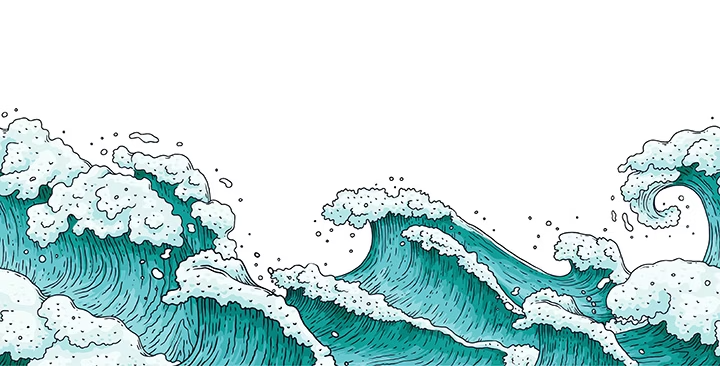Motion graphics explained: definition, history and examples.
From classic Hollywood films to cutting-edge Instagram content, creatives have used motion graphics to tell stories for decades. But how is motion graphics animation used, what is its history and how do you get started creating it? Read on to get the full story.

What are motion graphics?
Motion graphics are essentially ‘graphics with movement’. The emergence of the technique in the mid-20th century transformed the discipline of graphic design, which until then had centred on static graphics.
When talking about motion graphic design, creatives are referring to the combination of text and design elements set to motion.
Motion graphics animation doesn’t mean a full-blown animated film, like a Disney film with defined characters, plot and narrative arc. Instead, it generally refers to shorter pieces of animation that entertain or impart information. 3D motion graphics, for example, are prominently used in adverts.
Motion graphics grew in prominence during Hollywood’s post-war golden age, but it was the evolution of digital technology decades later which brought the discipline to a much wider audience of creators. Common examples include film and TV opening credits and advertising creative.
What are motion graphics used for?
Film studios pioneered the discipline from the 1950s, using graphic designers to create film titles that not only listed the cast and crew but also conveyed the sense of a film through colour, text, illustration style and pacing of movement.
To this day, film opening credits utilise motion graphic design, with digital technology democratising the discipline to open it up to creators at all levels. But motion graphics are also used for:
- TV opening credits. TV miniseries have long used motion graphics for their opening credits. Check out the latest Netflix boxset.
- Advertising creative. Motion graphics have enabled advertisers to create bolder, more interactive creative for their clients.
- News broadcasting. Motion graphics help broadcasters and journalists tell stories more effectively, especially at times of news events like elections.
- Social media memes. Many memes you’ll see on Instagram use motion graphics to make you laugh — combining imagery, text and movement.
- Website UX design. As more of our daily lives have moved online, so designers have focused on improving our user experience, using motion graphics.
- Retail experiences. As menu boards and billboards in shopping centres went digital, the flat, static print format came alive with motion graphics.
Fascinated by the world of animation?
Keep learning by reading our beginner's guide to animation.

History of motion graphics.
The origins of motion graphics are rooted in the evolution of film credits. In the early days of cinema, directors created title credits to meet the interest of this new generation of cinemagoers, who wanted to learn more about the actors in the films they saw.
The motion graphics in cinema trend really took off post World War Two. Graphic designers such as Saul Bass and Elaine Bass pioneered a new era of bold, colourful and creative motion graphics that brought films such as The Seven Year Itch (1955) and North by Northwest (1959) to life.
Other iconic film title designers of the 1960s and 1970s include Pablo Ferro, famed for Dr Strangelove (1964) and The Thomas Crown Affair (1968).
The digital age of motion graphics.
The arrival of digital technology in the late 20th century had a huge impact on motion graphics design. The Apple Mac landed in the early 1980s, empowering designers to create even more inventive title credits for films and TV shows.
Though the technology of the 1980s looks primitive today, by comparison with what had been available in the 1960s and 1970s, it amounted to a creative revolution. And as digital technology has advanced further in recent years with software such as Adobe Premiere and Adobe After Effects, the creative capabilities of designers have increased.
The Netflix-era of TV miniseries.
As television grew in popularity, the creators of popular TV shows employed the motion graphics principles of cinema. Early versions of TV credits from the 1970s and 1980s were basic. But as TV has grown to rival cinema, that gap has narrowed. Today, big-budget miniseries on HBO or Netflix boast opening credits to rival anything seen in Hollywood - with 3D motion graphics in particular providing some memorable title sequences.
The advertising and social media age.
The advent of the Internet, social media and digital advertising in the 2000s ushered in a new era of motion graphic design. Creative agencies began to employ talented designers to create short, animated (and often annotated) graphics to advertise their client’s products and services — often to break down complex processes into simple steps.
Using motion graphics to inform the world.
Infographics developed as a medium throughout the 2010s, aided by initiatives such as The Information is Beautiful Awards. But as social media became more prominent, many designers began to animate their flat infographics to tell more engaging stories that used motion to bring data and charts to life.
Examples of motion graphics
The Seven Year Itch (1955).
The opening credits of The Seven Year Itch, designed by Saul Bass, broke up the frame into a series of animated boxes in bold colours which opened and closed and appeared and disappeared to reveal the names of stars such as Marilyn Monroe and screenwriter Billy Wilder.
Game of Thrones (2011-2019).
The iconic HBO series based on the books of George R.R. Martin took readers to a vivid fantasy world. The design team behind it chose to use the opening credits to give context to that imaginary world, as the viewer journeys around a map of the different locations.
The ABC of Architects.
Named a staff pick by video-sharing platform Vimeo, this charming animation tells the history of architecture with a motion graphic design for the letters of the alphabet. Created by Andrea Stinga and Federico Gonzalez.
The Life of Spartacus.
Fiona Radford created this engaging animation for the Ted Ed site. It uses animation and a voiceover to tell the story of Spartacus and the creation of Sparta. Cleverly, the designer has based the animation on paintings found on ceramics from Ancient Rome.
How to create motion graphics.
Whether you’re creating opening credits for a film or social media posts for your small business, you can easily make words and pictures move with Adobe After Effects. With it you can:
- Move an object through the scene with animation
- Create background effects such as flowing patterns
- Easily add flickering and wiggling movements
- Introduce motion graphics to an existing video
- Create visual effects such as motion blur
Learn as much as you can about After Effects.
Adobe After Effects is one of the main tools motion designers use day to day. So, our first bit of advice on learning how to create motion graphic would be to spend as much time as possible getting to know After Effects.
4 After Effects tutorials for motion graphics.

Motion graphic basics.
To develop a career in motion graphics or even to become a skilled motion graphic design hobbyist, you should focus on building certain skills, behaviours and practices. Here are some to consider.
- Put in the hours. To master motion graphics, you need to be prepared to spend long hours learning how to use software such as Adobe After Effects and reading up to understand the principles of design.
- Just do something. That said, you should experiment with basics designs as soon as you have that limited knowledge. Don’t try to know everything before you start work - it’s just not possible and could hinder your development.
- Learn from the best. From films at ad campaigns, there’s so much excellent motion graphic design to explore. Watch the opening credits of films like Catch a Thief to learn from the great Saul Bass.
- Find your style. Though you should learn from the greats, try to find your own distinctive visual voice and style. What inspired you to become an artist in the first place? That’s often a good place to start.
- Set down foundations. Before diving into a project headfirst, plan it out. Motion graphics is a complex discipline. Think about whether your vision is viable before spending 100s of hours on it, only to find it’s not.
Motion graphics FAQs.
What does a motion graphic designer do?
A motion graphic designer creates animated graphics for film and TV credits, advertising and digital marketing, website design, social media channels and more.
Predominantly, they work with digital technology such as Adobe After Effects to bring movement to graphics and text. But they also spend a lot of time collaborating with colleagues with different skillsets, such as copywriters, illustrators and web developers.
How do I become a motion graphics designer?
To become a motion graphics designer, you will most likely already have an interest in and talent for art and graphics. After school, you should choose a design-focused degree at college. Try to find something that covers plenty of digital.
At the same time, build your skills with the relevant, industry-standard software tools and being to create a digital portfolio of your work. After college, use your portfolio of work to begin looking for your first role, often at an agency. Or start pitching for freelance opportunities.
What are some examples of motion graphics?
Good examples of motion graphics span the decades and creative mediums. Starting with film, the opening credits of The Thomas Crown Affair (1968) are an early motion graphics example.
Fast-forward to generation YouTube and you find informative motion graphics such as Cinematics, a Vimeo Staff Pick animation showing a chronological timeline of classic films.